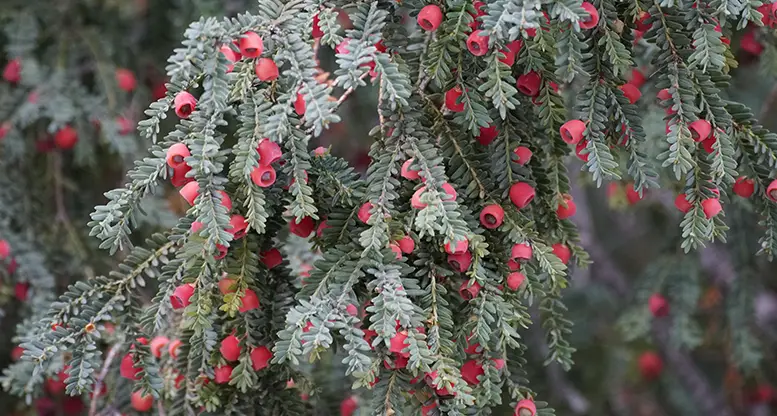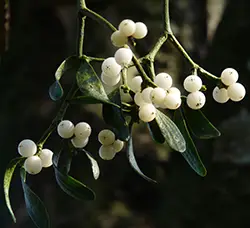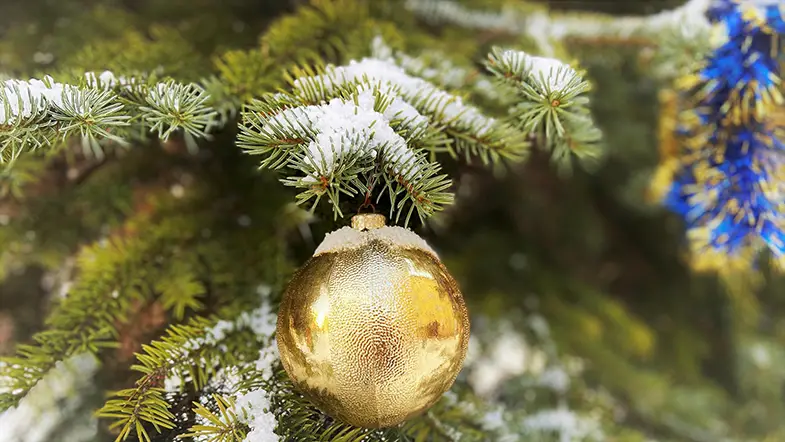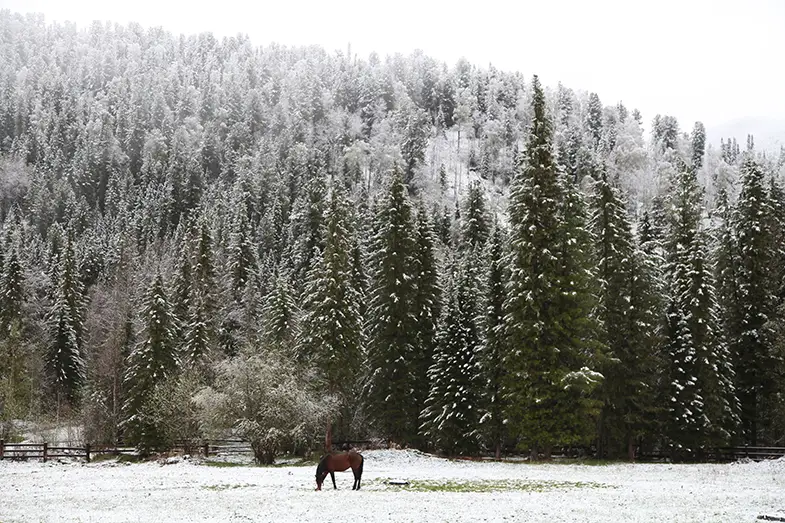If you live near a Christmas tree farm or aren’t sure what to do with your Christmas tree after the twelfth night then you might be wondering if they’re okay for horses to eat. I know it’s something that I’ve often thought about so decided to research whether or not Christmas trees were safe for horses to eat.
Are Christmas trees safe for horses to eat? As a general rule, Christmas trees are perfectly safe (and even beneficial) for horses to eat, but it does depend on the type of tree. The most common Christmas trees are fir and spruce which are all safe for horses. Yew trees should never be fed to horses though, nor should Blackjack or Monterey.
Can horses eat Christmas trees?
The best way to answer whether or not horses can eat Christmas trees is to say that it depends on the type of tree. The most common Christmas trees (in the US at least) are firs (such as Douglas, Fraser, Noble, and Nordmann), spruces (such as Norway), and pines (like the Scotch and White) which are all safe for horses to eat as long as they haven’t been sprayed to prevent the leaves from falling. It’s not just the needles that are okay for horses to eat, even the bark is okay for them.
The only caveat I would add to feeding Christmas trees to horses though is that most trees contain resin (which is why they burn so well) which can irritate some horses and is also a nightmare to get out of their coats.
If you’re not sure about whether something is okay to feed to your horse or not, then don’t do it without speaking to your vet for professional advice first. They will also know your horse’s medical history and will be aware of any reasons why they shouldn’t eat certain things.
What type of Christmas trees should you avoid feeding to horses?
While most Christmas trees are okay for horses to eat there are a few types of pine tree that should be avoided at all costs. The most poisonous of these is Ponderosa (also known as Blackjack or Monterey). In most cases, it will only cause mild stomach pain but it can, in extreme cases, affect the central nervous system. In pregnant mares, it can also result in the pregnancy being aborted, a miscarriage, or even premature birth.
Yew trees should also be avoided, even in small amounts, they can be fatal to a healthy adult horse. Thankfully though they are very rarely used as Christmas trees.
Are Christmas decorations poisonous to horses?
Many of us like to use natural Christmas decorations rather than shiny plastic ones but after Christmas, it can be difficult to know what to do with them. Of course, they can be put on the compost heap and used to help grow next year’s decorations but you might be surprised to know that some of them can actually be fed to your horse instead.
Garlands that have been made of spruce or pine (as long as it’s not Blackjack or Monetary Pine) can be fed to horses as long as you remove all of the artificial embellishments first. Not only are they okay to feed to your horse but they can also have health benefits too and are high in vitamin C but they can also help to alleviate some respiratory issues.
What might surprise you though is that, as long as they don’t eat too much, poinsettias are okay for horses to eat. The sap can be mildly toxic if fed in very large quantities but I really do mean VERY large amounts.
While spruce and the occasional poinsettia are okay for horses to eat you should never feed them mistletoe or let it grow where they can easily reach it. Mistletoe is highly toxic to horses and can cause gastrointestinal and cardiovascular issues as well as labored breathing, a slow heart rate, tremors, and even seizures. You should also avoid feeding holly to horses, while it’s not as toxic to horses as mistletoe it can still be serious. As well as causing digestive problems it can also make it difficult for the horse to swallow. Even if your horse suffers no ill effect from the toxics, the sharp points on the leaves will harm him and cut his mouth.
How to safely decorate your horse’s stall for Christmas
We’ve all been there it’s the start of December (or even earlier if you’re anything like me) and you decide you want to decorate your horse’s stall so that he can get some of that festive cheer too. The trouble is not everything is safe for your horse and even things that are safe can still cause problems.
The best way to decorate your horse’s stall is to use natural decorations such as spruce garlands and to make sure they’re hung well out of reach of your horse, otherwise, he may end up eating them long before the big day.
You can use Christmas lights but it’s better to use LED ones because they won’t get so hot if they’re left on for long periods of time. Like the garlands you should hang them well out of your horse’s reach, while he won’t eat them he will probably be curious.
Artificial decorations such as tinsel should be avoided unless you can be 100% sure there’s no chance of your horse getting to it and that it won’t fall. Unsurprisingly horses aren’t able to digest plastic and it can get stuck in their digestive tract, causing a blockage and ultimately leading to colic at best.
Why do horses eat Christmas trees?
Horses are generally sensible (don’t laugh they can be) and will normally avoid foods that are harmful to them, while at the same time seeking out foods that can be beneficial and Christmas trees are no exception. During the winter they can be a great source of vitamins, minerals, and other nutrients, providing extra nourishment when others foods are scarce. The needles are high in vitamin C while the inner bark is a great source of fiber. [source]
As an added bonus I’ve been assured by a friend who always feeds her horses Christmas trees they can make their farts smell of pine which I’m sure nobody will complain about, especially when you consider how bad they normally smell.
What can you do with your old Christmas tree if your horse won’t eat it?
Horses have well and truly earned the reputation of living garbage bins with their desire to eat pretty much anything and everything in sight, but there will also be the odd horse who bucks the trend and will turn their nose up at eating ‘normal horsey’ foods (I once knew a horse that didn’t like apples) as well as Christmas trees. If you happen to have one of these rare horses then don’t worry you can still make good use of your old Christmas tree.
If the branches still have their needles then they’re perfect for absorbing mud. Simply cut the branches off of the trunk and lay them on areas where there’s a lot of mud. This is often around areas such as gates and water troughs that have a lot of traffic with horses coming in and out of the pasture all of the time. Put a few branches down and you’ll be amazed at how quickly it disappears.
Conclusion
Most Christmas trees are okay for horses to eat, often having additional nutritional benefits but if you do feed them to your horse after Christmas make sure you’ve removed all of the decorations beforehand. Not all horses will eat Christmas trees though so if your horse doesn’t fancy them don’t worry, you can use them to absorb mud instead.
I hope you found this article helpful. If you did I’d be grateful if you could share it please as it would really help me.
Recommended products
Over the years I have tried hundreds of different horsey products, from various blankets and halters to different treats. Some I’ve loved, others I’ve hated but I thought I’d share with you my top all-time favorite products, the ones I never leave the yard without. I’ve included links to the products (which are in no particular order) that I really think are great.
- Horse Knots by Reference Ready – If you’re like me and enjoy pocket reference guides then you’ll love this knot tying guide. These handy cards can easily fit in your pocket or attach to the saddle for quick reference. They’re waterproof, durable and are color coded to make them easy to follow.
- Mane ’n Tail Detangler – Even if you never show your horse you’ll need to detangle his tail from time to time (and possibly his mane too) which is always a challenging chore! I’ve found that if I run a little bit of detangler through my horse’s tails every few days it stops them from getting matted up and makes combing them easy, even if they’re coated in mud. I don’t know if I should admit to this or not but it also works wonders on my hair.
- TAKEKIT Pro clippers – Over the years I’ve tried a lot of different clippers and while some were obviously better than others I found these to be by far the best. They are heavier than a lot of other clippers but for me, that’s a good thing, it makes them feel more sturdy and hardwearing. On top of that they have a range of speeds so are just as good for clipping your horse’s back as they are his face. I also like the fact that they come in a handy carry case but that’s not for everybody. The company that makes them is super good and incredibly helpful too, a real bonus these days. The only thing I wasn’t keen on was the fact that it doesn’t come with any oil, but that’s not a major problem as it’s not difficult to buy lubricant.
- Shire’s ball feeder – There are so many boredom buster toys out there but I like to use these every day, regardless of whether or not my horses are bored. I find that it helps to encourage my horses to problem solve by rewarding them with treats (or pieces of fruit) but it also mimics their natural grazing behavior which helps to keep them calm and de-stressed.
- Horse safe mirror – This is a strange one that many people are surprised about but I like to put horse safe mirrors in the trailers as well as in the quarantine stalls. It helps to prevent the feeling of isolation by giving the impression of other horses being around. Being herd animals horses can get extremely stressed when they feel that they’re on their own but with these stick-on mirrors, they believe that at least one other horse is with them.
- Rectal thermometer – I know this isn’t glamourous at all but it’s vital for your horse’s well-being to be able to check their temperature and a rectal thermometer is the easiest way of doing this which is why I’ve added it to the list.
Shopping lists
I’ve also put together a few shopping lists of essential items that I’ve found helpful over the years. I’ve broken the lists down into different categories rather than put everything in one massive list 😉




